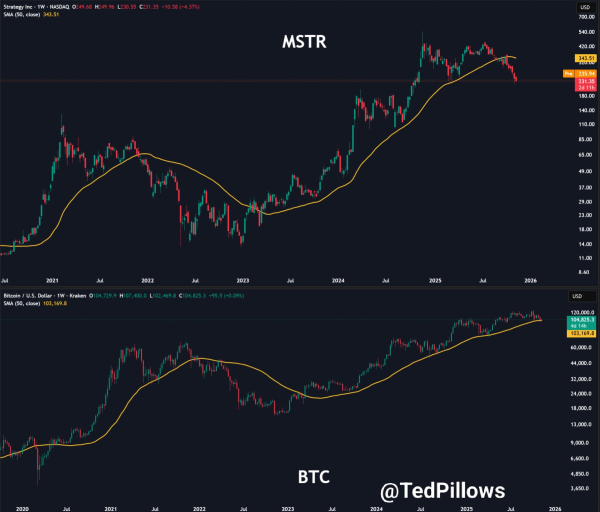How MicroStrategy Dies: The Market No Longer Believes in Saylor's Strategy

Michael Saylor's MicroStrategy (Strategy) is entering a period where its market value is increasingly below the value of its Bitcoin reserves, including debt. This divergence heightens the focus on the company's sustainability and reflects the risk profile that may affect Bitcoin.
Market capitalization is declining faster than the reserve value, and this trend is becoming a dangerous factor for market participants. We explain how the MicroStrategy model, which controls over 3% of the Bitcoin supply, is dying.
What's Happening with MicroStrategy?
MicroStrategy, the largest publicly traded Bitcoin investor, can be conveniently assessed using the mNAV metric. This metric is the ratio of the company's market capitalization to the value of its Bitcoin reserves after deducting liabilities. When the mNAV falls below 1, the stock is valued at a lower price than the Bitcoin on the balance sheet, including debt. This ratio highlights mounting pressure on the company and indicates the vulnerability of its financial model.
 MicroStrategy mNAV metric
MicroStrategy mNAV metric
The return over the last 12 months looked like this:
- Bitcoin: about +12%
- MSTR shares: about -35-40%
The difference in dynamics shows that MicroStrategy is significantly lagging behind Bitcoin's movement.
Calculations show that the mNAV could decline to levels around 0.2. This means that MicroStrategy's market value could fall by 70-80% relative to the value of its Bitcoin reserves. In this situation, three main scenarios emerge:
1. Distribution of capital among shareholders .
If shareholders demand a partial refund, MicroStrategy will be forced to sell its Bitcoin. This decision will increase pressure on the market.
2. Voluntary or compulsory liquidation .
This option would involve selling the entire Bitcoin reserve. A sharp increase in supply could cause a sharp decline in the price.
3. Inability to pay off obligations .
If the debt is due and there are insufficient funds, forced liquidation begins, accompanied by the sale of reserves.
What factors are increasing pressure on MicroStrategy?
The company's situation is complicated by several important elements:
- The issue of new shares dilutes shareholders' shares.
- Some financing instruments are too cheap and do not allow you to attract capital.
- There is virtually no demand for new instruments for raising funds.
- About $15 million a week goes towards operating expenses, interest and dividends.
- Arbitrage strategies are gradually closing down.
- ETFs are cutting their holdings of MSTR following its market cap decline.
Debt to Reserve Value Ratio
When the value of the Bitcoin reserve falls below the amount of liabilities, the company loses the ability to cover the debt even by selling off the asset entirely. This structure increases the likelihood of harsh actions by creditors.
MicroStrategy's average BTC purchase price of approximately $74,000 reflects only the company's transaction history. It does not impact the company's ability to service its liabilities. Sustainability is determined by the current asset-to-debt ratio, not the average purchase price.
MicroStrategy invested over $27 billion in Bitcoin over the past year, or about $500 million per week. These investments have not led to sustainable price growth. A significant portion of the volume is either without significant profit or at a loss, with a growing debt burden.
MicroStrategy shares fell below their 50-week moving average and failed to recover. Bitcoin also broke through this mark and is currently near it. The moving average reflects long-term movement, and the convergence of such signals reinforces the risk of further decline.
 Strategy stock and Bitcoin relative to the 50-day moving average. Source: X analyst Ted Pillouse
Strategy stock and Bitcoin relative to the 50-day moving average. Source: X analyst Ted Pillouse
Why the situation remains tense
The decline in mNAV, high leverage, the closure of arbitrage strategies, and the reduction in ETF holdings create a risk structure that could translate into pressure on Bitcoin. These processes are developing gradually and remain relevant over time.
Result
MicroStrategy is rapidly losing value relative to its Bitcoin holdings. Its mNAV is falling into the zone where leverage is becoming a dominant factor. Capital raising options are limited, expenses are rising, and the stock price is declining faster than the price of Bitcoin.
If this trend continues, the company will be forced to use part of its reserves to service debt and maintain operations. In extreme cases, this will lead to the sale of significant amounts of Bitcoin, either voluntarily or under pressure from creditors.
Source: cryptonews.net



